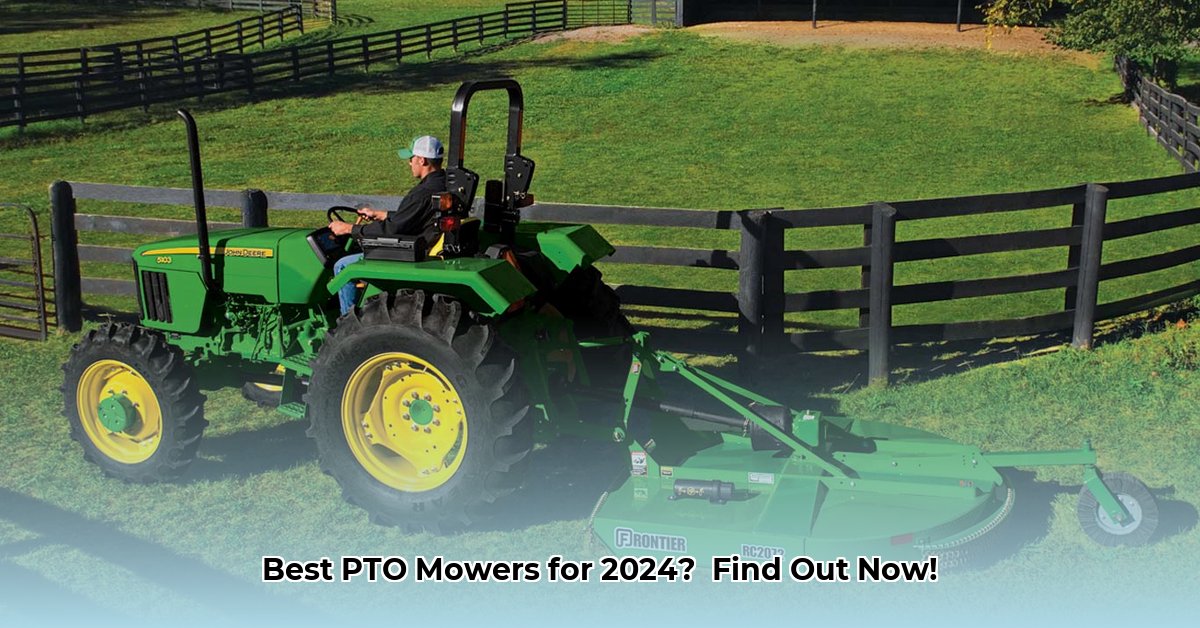
Choosing the right PTO mower for your tractor is a significant investment impacting farm efficiency and profitability. This comprehensive guide simplifies the selection process, covering mower types, key features, maintenance, and more. Whether you're a seasoned farmer or a new landowner, this guide equips you to make an informed decision. For more information on lawn tractors, check out this helpful resource: tractor supply guide.
Understanding Your Mowing Needs: Before You Begin
Before browsing PTO mowers, ask these crucial questions:
- Budget: PTO mowers range significantly in price. Defining your budget upfront is essential.
- Land Area: The size of your property dictates the necessary cutting width and mower capacity. A small yard requires a different mower than a large farm.
- Terrain: Flat, rolling, or hilly terrains demand different mower designs and capabilities. Rugged terrain requires a heavier-duty model.
- Vegetation Type: The type of vegetation—grass, weeds, or brush—influences the cutting style (shredding vs. clean cut) and mower design needed. Thick brush necessitates a more robust mower.
Answering these questions honestly is the first step toward selecting the right PTO mower.
PTO Mower Types: A Detailed Comparison
Several PTO mower types cater to various needs:
Rotary Mowers: These workhorses are the most common type, using spinning blades to chop vegetation. Their versatility suits various applications from lawns to fields.
Flail Mowers: Built for rugged use, flail mowers utilize swinging hammers (flails) for tackling thick vegetation and rough terrains. Expect a more shredded cut than with rotary mowers.
Disc Mowers: Ideal for hay production, disc mowers feature rotating discs with blades, generating a clean cut. They're best suited for flatter, less cluttered areas.
Choosing the best type depends on your specific terrain and vegetation characteristics. What type of vegetation will you be cutting the most often?
Key Features to Consider for Optimal Performance
Several features significantly impact PTO mower performance and longevity:
Cutting Width: This determines the swath cut in a single pass (e.g., 5 ft, 7 ft, 10 ft). Wider cuts increase speed but require more tractor horsepower. Are you prioritizing speed or maneuverability?
Horsepower Requirements: Ensure your tractor has sufficient horsepower to operate the mower safely and efficiently. Underpowering a mower leads to breakdowns and poor cuts. Overpowering is rarely a problem, however.
Gearbox: The gearbox transfers power from the tractor to the mower's cutting mechanism. A durable gearbox is crucial for long-term reliability. Is a robust gearbox worth the extra investment, given your terrain and vegetation?
Blade Material: Blade material directly impacts lifespan and sharpness. High-quality materials like hardened steel or carbide provide cleaner cuts and longer service life. How will you maintain your blades, and how often?
Selecting Your Ideal PTO Mower: A Step-by-Step Approach
Assess Your Needs: Revisit the initial questions about budget, land area, terrain, and vegetation.
Choose a Mower Type: Select a rotary, flail, or disc mower based on your needs.
Specify Key Features: Determine the desired cutting width, consider horsepower requirements, evaluate gearbox robustness, and choose appropriate blade material.
Compare Models: Research different brands and models, comparing specifications and features. Consider user reviews and seek recommendations from experienced users.
Consult with Experts: Seek advice from local dealers or agricultural professionals. Their insights can prevent potential pitfalls.
Make Your Purchase: Once you've considered your specific needs and done your research, you can confidently make your purchase.
Essential PTO Mower Maintenance for Optimal Lifespan
Regular maintenance ensures your mower's long-term performance:
Regular Blade Inspections: Inspect blades regularly for damage. Sharpen or replace dull or damaged blades promptly to maintain cutting quality and prevent further damage.
Consistent Lubrication: Keep moving parts well-lubricated according to the manufacturer's recommendations. This reduces friction and extends the mower's lifespan.
Gearbox Monitoring: Regularly inspect the gearbox for leaks or unusual noises, ensuring proper lubrication.
Post-Use Cleaning: Thoroughly clean your mower after each use to prevent corrosion and damage. Remove debris, grass, and other materials.
Following these steps will significantly extend your PTO mower's lifespan and ensure optimal performance.
Key Takeaways: Making the Right Choice
- Matching the mower to your specific needs is crucial. Consider your budget, terrain, and vegetation type before you start shopping.
- Regular maintenance is essential for longevity and performance. Implement a routine inspection and cleaning schedule.
- Thorough research is key to a sound investment. Compare models, read reviews, and seek expert advice before making a purchase.
By following this guide, you can confidently select and maintain a PTO mower that enhances your farming operations for years to come.